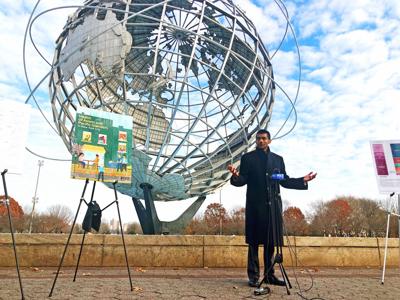Beneath the Unisphere, city Health Commissioner Dave Chokshi unveiled a groundbreaking report detailing the health of Asian and Pacific Islander New Yorkers, differentiated by ancestry.
“That disaggregated data is extremely important for us to lay bare exactly what is happening across the remarkable cultural and ethnic diversity and is represented by Asian and Pacific Islanders,” the “city’s doctor” said at a Dec. 10 press conference. “We are anything but homogeneous.”
The “Health of Asians and Pacific Islanders in New York City” report touched on many factors of health, from blood pressure to vaccinations and suicide. The comprehensive report highlights the differences between those with various Asian and Pacific Islander heritages and how unreliable it is to place the communities under the “API umbrella,” especially because 48 countries are typically considered API, he said.
For example, the report found that 12 percent of adult Indian New Yorkers drink alcohol in excessive amounts, compared to 24 percent of Korean New Yorkers. The average for APIs, however, is just 10 percent. The report also found that sugary drink consumption varies from 7 percent among East Asian adults to 28 percent among Native Hawaiian and Pacific Islander groups.
“Ignoring these distinctions renders vulnerable people invisible in the eyes of our healthcare system,” said Assemblymember Jenifer Rajkumar (D-Woodhaven), the first South Asian woman elected to the Assembly.
The report included a note on Covid-19’s impact on API communities, also called AAPI for Asian American and Pacific Islander, particularly the rise in prejudice and hate crimes against them. The city Health Department declared racism a public health crisis in October.
But the inequities APIs face began over 200 years ago and led to the misrepresentation that exists today, Chokshi said. The report includes a timeline, beginning in 1587, that outlines the history of Asians in North America and the exclusionary U.S. immigration policies and discrimination that followed and shaped health policies today.
“Almost 100 years ago, the Supreme Court ruled in the United States vs. Bhagat Singh Thind case that Indians were ineligible for naturalized citizenship because they’re not considered white. But half a century later, my own parents immigrated to this country from India and became naturalized citizens. Half a century after that, their son became the first NYC commissioner of Asian decent,” Choski said, adding that the landmark report was created “so it doesn’t take another half a century to make progress on the health of Asians and Pacific Islanders in this city.”
The goal of the 50-page report, Choski said, is to better understand where health inequities exist so that the city can prevent disease, and increase community well-being.
The report was made through collaboration with 21 other partners, including the Flushing-based South Asian Council for Social Services and Bayside-based Korean Community Services.












Commented
Sorry, there are no recent results for popular commented articles.